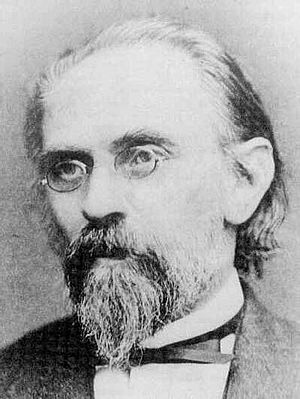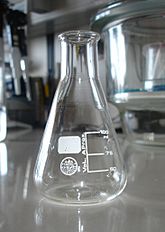Emil Erlenmeyer facts for kids
Quick facts for kids
Emil Erlenmeyer
|
|
|---|---|
 |
|
| Born |
Richard August Carl Emil Erlenmeyer
28 June 1825 Wehen, Duchy of Nassau, today Taunusstein, Germany
|
| Died | 22 January 1909 (aged 83) |
| Nationality | German |
| Alma mater | University of Gießen |
| Known for | Erlenmeyer flask Erlenmeyer rule |
| Scientific career | |
| Fields | Organic chemistry |
| Institutions | Munich Polytechnic School |
Richard August Carl Emil Erlenmeyer (born June 28, 1825 – died January 22, 1909), known simply as Emil Erlenmeyer, was an important German chemist. He helped develop early ideas about how chemical structures are built. He also created the Erlenmeyer rule and designed the famous Erlenmeyer flask. This special flask is used everywhere in chemistry labs and is named after him.
Contents
Emil Erlenmeyer's Life Story
Early Years and Schooling
Emil Erlenmeyer was born in 1825 in a place called Wehen, which is now part of Taunusstein, Germany. His father was a Protestant minister. Emil first went to the University of Giessen to study medicine.
However, after listening to lectures by a famous chemist named Justus von Liebig, Emil changed his mind. He decided to study chemistry instead. In 1846, he spent a year in Heidelberg studying physics, botany, and mineralogy. He returned to Giessen in 1847.
After working as an assistant to other chemists, Erlenmeyer decided to focus on pharmaceutical chemistry. This involves chemistry related to medicines. He passed a special exam in Nassau and then bought a pharmacy business. He ran pharmacies in Katzenelnbogen and Wiesbaden.
Returning to Chemistry Studies
Emil Erlenmeyer wasn't completely happy with pharmacy. So, he went back to studying chemistry. He finished his advanced degree (doctorate) at Giessen in 1850.
In 1855, he moved to Heidelberg. There, he worked in the lab of Robert Bunsen on chemicals used for fertilizers. Erlenmeyer wanted to teach, but Bunsen's assistants weren't allowed to have their own students. So, with help from his wife, he turned a shed into his own private lab!
In 1857, he became a private teacher (called a privatdocent). His research paper described several crystal substances that interested Robert Bunsen. While in Heidelberg, Erlenmeyer was influenced by August Kekulé. Kekulé had new ideas about how molecules were structured, and Erlenmeyer was one of the first to use them.
Big Ideas in Chemistry
In 1862, Erlenmeyer was the first to suggest that carbon atoms could form double and triple bonds with each other. This was a very important idea for understanding how molecules are shaped. He made many other key contributions to the development of molecular structure theories.
Becoming a Professor
In 1863, Erlenmeyer became an associate professor at the University of Heidelberg. Then, in 1868, he became a full professor in Munich. He was put in charge of the labs at the new Munich Polytechnic School. He held this important job until he retired from teaching in 1883.
Most of Erlenmeyer's work focused on theoretical chemistry. He suggested the chemical formula for a substance called naphthalene. He also came up with the Erlenmeyer rule. This rule explains that certain types of alcohols (where a special group called a hydroxyl group is attached to a double-bonded carbon atom) will change into other compounds called aldehydes or ketones.
Practical Chemistry Discoveries
Erlenmeyer also did many practical experiments. He mostly studied aliphatic compounds, which are a type of organic chemical.
- In 1859, he created aminohexoic acid. He then studied how proteins (called albuminoids) break down.
- He found ways to measure the amounts of leucine and tyrosine. These are substances produced when other chemicals break down.
- In 1860, he was the first to understand the nature of glycide. He suggested it was related to glycerol in a similar way that two types of phosphoric acid are related.
- In 1861, he studied how hydroiodic acid reacted with glycerol. He showed that the product was isopropyl iodide and not propyl iodide.
- His studies of higher alcohols (produced during fermentation) proved that these alcohols were not part of the "normal" chemical series.
His other important work included:
- Finding glycolic acid in unripe grapes (1864).
- Making sodium oxalate by heating sodium formate (1868).
- Breaking down ether into alcohol (1858).
- Creating phenyl-lactic acid (1880).
- Preparing pyruvic acid by distilling tartaric acid (1881).
- Forming carbostyril from quinoline (1885).
Erlenmeyer also studied chemicals in the aromatic series. He looked at different forms of cinnamic acids. In 1882, he created tyrosine from phenylalanine. In 1875, he proved that there were not more than three types of nitrobenzoic acids, which was a common belief at the time.
The Erlenmeyer Flask
In 1860, Emil Erlenmeyer published a description of the special conical flask that is now named after him: the Erlenmeyer flask. This flask has a flat bottom, a conical body, and a cylindrical neck. It's very useful for mixing, heating, and storing liquids in labs.
See also
 In Spanish: Emil Erlenmeyer para niños
In Spanish: Emil Erlenmeyer para niños


